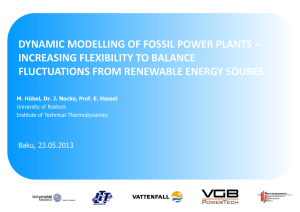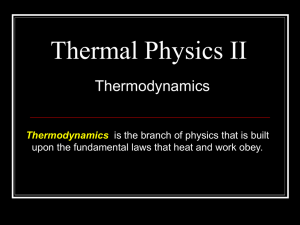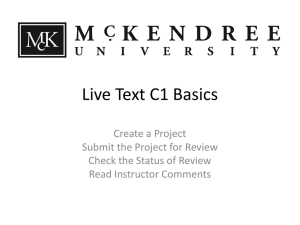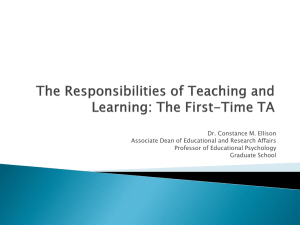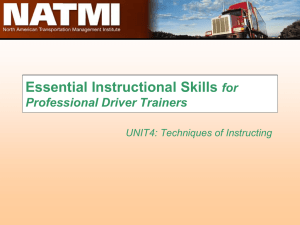Chapter 5-1
advertisement
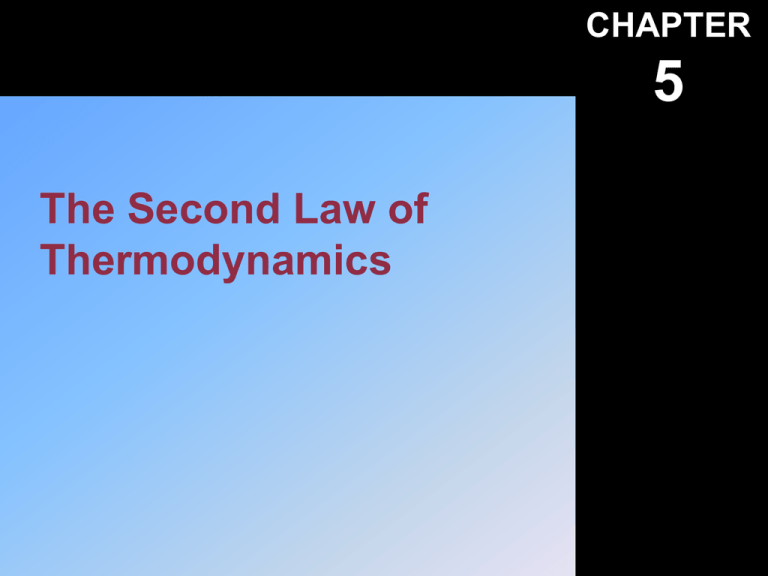
CHAPTER 5 The Second Law of Thermodynamics The process One kg of air, initially at 5 bar, 350 K and 3 kg of carbon dioxide, initially at 2 bar and 450 K, are confined to opposite sides of a rigid, well insulated container. The partition is free to move and allows heat conduction from one gas to the other without energy storage in the partition. The air and carbon dioxide each behave as ideal gases. Determine the final equilibrium temperatures and final pressures, assuming constant specific heats. Instructor’s Visual Aids Heat Work and Energy. A First Course in Thermodynamics © 2001, F. A. Kulacki Chapter 5 Module 1 Slide 2 Introduction to the Second Law - The Direction of Natural Processes Adiabatic Boundary Insulation (Q = 0) The system Air 1 kg 5 bar 350 K Partition Movement with Heat Transfer Instructor’s Visual Aids Heat Work and Energy. A First Course in Thermodynamics © 2001, F. A. Kulacki Carbon Dioxide 3 kg 2 bar 450 K Chapter 5 Module 1 Slide 3 Introduction to the Second Law - The Direction of Natural Processes • Known – Initial states of the two gases – Closed system – Free motion of partition – Heat flow between the two gases. • Assume – Both gases are ideal with constant specific heats. – WS = 0. – No heat stored in partition. – KE and PE effects negligible. – No friction in partition. • Find – Final pressures – Final temperatures Instructor’s Visual Aids Heat Work and Energy. A First Course in Thermodynamics © 2001, F. A. Kulacki Chapter 5 Module 1 Slide 4 Introduction to the Second Law - The Direction of Natural Processes Solution • Apply First Law –Total energy of the combined system is constant. • Apply Zeroth Law –Thermal equilibrium in the final equilibrium state (TA2 = TB2). Instructor’s Visual Aids Heat Work and Energy. A First Course in Thermodynamics © 2001, F. A. Kulacki Chapter 5 Module 1 Slide 5 Introduction to the Second Law - The Direction of Natural Processes • Once equilibrium has been reached via this adiabatic process (overall), can the system of A+B go back to the initial state spontaneously? Instructor’s Visual Aids Heat Work and Energy. A First Course in Thermodynamics © 2001, F. A. Kulacki Chapter 5 Module 1 Slide 6 Introduction to the Second Law - The Direction of Natural Processes “Everyone realizes that the reverse process cannot happen. But why not? The total energy of [the isolated] system would remain constant in the reversed process as it did in the original, and there would be no violation of the first law. There must therefore be some other natural principle, in addition to the first law and not derivable from it, which determines the direction in which a process can take place in an isolated system.” (W. F. Sears, Thermodynamics, Addison Wesley, Reading, 1953, pp. 110.) Instructor’s Visual Aids Heat Work and Energy. A First Course in Thermodynamics © 2001, F. A. Kulacki Chapter 5 Module 1 Slide 7 Introduction to the Second Law - The Direction of Natural Processes Other natural processes... Instructor’s Visual Aids Heat Work and Energy. A First Course in Thermodynamics © 2001, F. A. Kulacki Chapter 5 Module 1 Slide 8 Introduction to the Second Law - The Direction of Natural Processes Natural processes • Spontaneous processes –How do they use energy? • Inefficiencies –How do they arise? Instructor’s Visual Aids Heat Work and Energy. A First Course in Thermodynamics © 2001, F. A. Kulacki Chapter 5 Module 1 Slide 9 Introduction to the Second Law - The Direction of Natural Processes Natural processes • Water flows down hill. • Objects fall to the earth and never rebound to their original elevation. Instructor’s Visual Aids Heat Work and Energy. A First Course in Thermodynamics © 2001, F. A. Kulacki Chapter 5 Module 1 Slide 10 Introduction to the Second Law - The Direction of Natural Processes Natural processes • Power plants eject hot fluid into streams that cannot be recovered to do useful work. • Refrigerators eject heat into the surroundings that cannot be recovered to do useful work. Instructor’s Visual Aids Heat Work and Energy. A First Course in Thermodynamics © 2001, F. A. Kulacki Chapter 5 Module 1 Slide 11 Introduction to the Second Law - The Direction of Natural Processes Common Experiences • Automobiles never extract the heating value of the gasoline fully and convert it completely into kinetic energy. Hot exhaust gases are emitted to the environment and that energy cannot be recovered to do work. • Heat exchangers cannot be run backwards to reheat and re-cool the fluid streams. Instructor’s Visual Aids Heat Work and Energy. A First Course in Thermodynamics © 2001, F. A. Kulacki Chapter 5 Module 1 Slide 12 Introduction to the Second Law - The Direction of Natural Processes A conjecture... “There must therefore be some other natural principle, in addition to the first law and not derivable from it, which determines the direction in which a process can take place in an isolated system.” (W. F. Sears, Thermodynamics, Addison Wesley, Reading, 1953, pp. 110. ) Instructor’s Visual Aids Heat Work and Energy. A First Course in Thermodynamics © 2001, F. A. Kulacki Chapter 5 Module 1 Slide 13 Introduction to the Second Law - The Direction of Natural Processes Thermal Energy Reservoirs • Large bodies of water or atmosphere – Can release or absorb large amounts of energy without a temperature change • • • • Two phase systems Industrial furnaces Sources and sinks Thermal pollution Instructor’s Visual Aids Heat Work and Energy. A First Course in Thermodynamics © 2001, F. A. Kulacki Chapter 5 Module 1 Slide 14 Introduction to the Second Law - The Direction of Natural Processes Copyright © The McGraw-Hill Companies, Inc. Permission required for reproduction or display. FIGURE 5-9 Part of the heat received by a heat engine is converted to work, while the rest is rejected to a sink. Heat Engine: A special device that allows the conversion of heat into work. 5-1 Heat engines: • Receive heat from a high-temp source – Solar, oil furnace, nuclear reactor, etc • Convert part of heat to work (rotating shaft) • Reject waste heat to low-temp sink – Atmosphere, rivers, lakes, etc. • Operate on a cycle. Instructor’s Visual Aids Heat Work and Energy. A First Course in Thermodynamics © 2001, F. A. Kulacki Chapter 5 Module 1 Slide 16 Introduction to the Second Law - The Direction of Natural Processes Copyright © The McGraw-Hill Companies, Inc. Permission required for reproduction or display. FIGURE 5-10 Schematic of a steam power plant. Shaded area is closed system, and cycle so Wout – Win will equal Qin - Qout External Combustion Engine – Thermodynamic Cycle Internal combustion engine – mechanical cycle – not a heat engine 5-2 Copyright © The McGraw-Hill Companies, Inc. Permission required for reproduction or display. FIGURE 5-14 Schematic of a heat engine. Efficiency? Work out compared to heat in. Thermal pollution can be a problem. 5-3 st 1 • • • • Law and Efficiency Wnet,out = Qin – Qout Thermal efficiency = net work out/heat in ηth = Wnet,out/Qin = 1 - Qout/Qin ηth = 1 – QL/QH Instructor’s Visual Aids Heat Work and Energy. A First Course in Thermodynamics © 2001, F. A. Kulacki Chapter 5 Module 1 Slide 19 Introduction to the Second Law - The Direction of Natural Processes Copyright © The McGraw-Hill Companies, Inc. Permission required for reproduction or display. FIGURE 5-16 A heat-engine cycle cannot be completed without rejecting some heat to a low-temperature sink, not a high-temperature reservoir to use again. One cannot save Qout! Waste heat is that used to heat up the gas. 5-4 Over arching fundamental ideas... Instructor’s Visual Aids Heat, Work and Energy. A First Course in Thermodynamics © 2001, F. A. Kulacki Chapter 5 Module 2 Slide 21 The Second Law of Thermodynamics - Additional Observations on the Nature of Processes and Cycles Central ideas & observations • There is a natural direction of all processes towards a state of lower potential to do work. Instructor’s Visual Aids Heat, Work and Energy. A First Course in Thermodynamics © 2001, F. A. Kulacki Chapter 5 Module 2 Slide 22 The Second Law of Thermodynamics - Additional Observations on the Nature of Processes and Cycles Central ideas & observations • There is tendency in all processes and cyclic devices to produce unrecoverable energy in either doing or consuming work. Instructor’s Visual Aids Heat, Work and Energy. A First Course in Thermodynamics © 2001, F. A. Kulacki Chapter 5 Module 2 Slide 23 The Second Law of Thermodynamics - Additional Observations on the Nature of Processes and Cycles Central ideas & observations •Thermal inefficiency is a part of all processes and cycles - there is always some wasted heat or work. Instructor’s Visual Aids Heat, Work and Energy. A First Course in Thermodynamics © 2001, F. A. Kulacki Chapter 5 Module 2 Slide 24 The Second Law of Thermodynamics - Additional Observations on the Nature of Processes and Cycles What can produce work? • Temperature differences. • Pressure differences. • Electric charge differences. • Electrical potential differences • Difference of chemical composition (chemical potential). Instructor’s Visual Aids Heat, Work and Energy. A First Course in Thermodynamics © 2001, F. A. Kulacki Chapter 5 Module 2 Slide 25 The Second Law of Thermodynamics - Additional Observations on the Nature of Processes and Cycles The expenditure of energy • Once the work is done, we cannot recreate these differences (i.e., the ability to do work) without providing additional energy (work or heat). Instructor’s Visual Aids Heat, Work and Energy. A First Course in Thermodynamics © 2001, F. A. Kulacki Chapter 5 Module 2 Slide 26 The Second Law of Thermodynamics - Additional Observations on the Nature of Processes and Cycles Clausius statement of the Second Law... Instructor’s Visual Aids Heat, Work and Energy. A First Course in Thermodynamics © 2001, F. A. Kulacki Chapter 5 Module 2 Slide 27 The Second Law of Thermodynamics - Additional Observations on the Nature of Processes and Cycles Clausius statement It is impossible for any system to operate in such a way that the sole result would be an energy transfer by heat from a cooler to a hotter body. Instructor’s Visual Aids Heat, Work and Energy. A First Course in Thermodynamics © 2001, F. A. Kulacki Chapter 5 Module 2 Slide 28 The Second Law of Thermodynamics - Additional Observations on the Nature of Processes and Cycles Kelvin-Planck statement of the Second Law... Instructor’s Visual Aids Heat, Work and Energy. A First Course in Thermodynamics © 2001, F. A. Kulacki Chapter 5 Module 2 Slide 29 The Second Law of Thermodynamics - Additional Observations on the Nature of Processes and Cycles Kelvin-Planck statement It is impossible for any system to operate in a thermodynamic cycle and deliver a net amount of work to its surroundings while receiving energy by heat transfer from a single thermal reservoir. Instructor’s Visual Aids Heat, Work and Energy. A First Course in Thermodynamics © 2001, F. A. Kulacki Chapter 5 Module 2 Slide 30 The Second Law of Thermodynamics - Additional Observations on the Nature of Processes and Cycles Other efficiencies • desired output/required input • Water heater – energy of hot water out over energy in (watch cost of energy in) • Motor – mechanical energy output over electrical energy input • Lighting – amount of light output over electrical energy input Instructor’s Visual Aids Heat, Work and Energy. A First Course in Thermodynamics © 2001, F. A. Kulacki Chapter 5 Module 2 Slide 31 The Second Law of Thermodynamics - Additional Observations on the Nature of Processes and Cycles Other efficiencies • For a power plant: – ηoverall = ηcombustion ηthermal ηgenerator= Wnet,electric/HHV ∙mnet – HHV = higher heating value – water leaves as a liquid – LHV = lower heating value – water leaves as a vapor Instructor’s Visual Aids Heat, Work and Energy. A First Course in Thermodynamics © 2001, F. A. Kulacki Chapter 5 Module 2 Slide 32 The Second Law of Thermodynamics - Additional Observations on the Nature of Processes and Cycles Copyright © The McGraw-Hill Companies, Inc. Permission required for reproduction or display. FIGURE 5-23 The efficiency of a cooking appliance represents the fraction of the energy supplied to the appliance that is transferred to the food. 5-5

